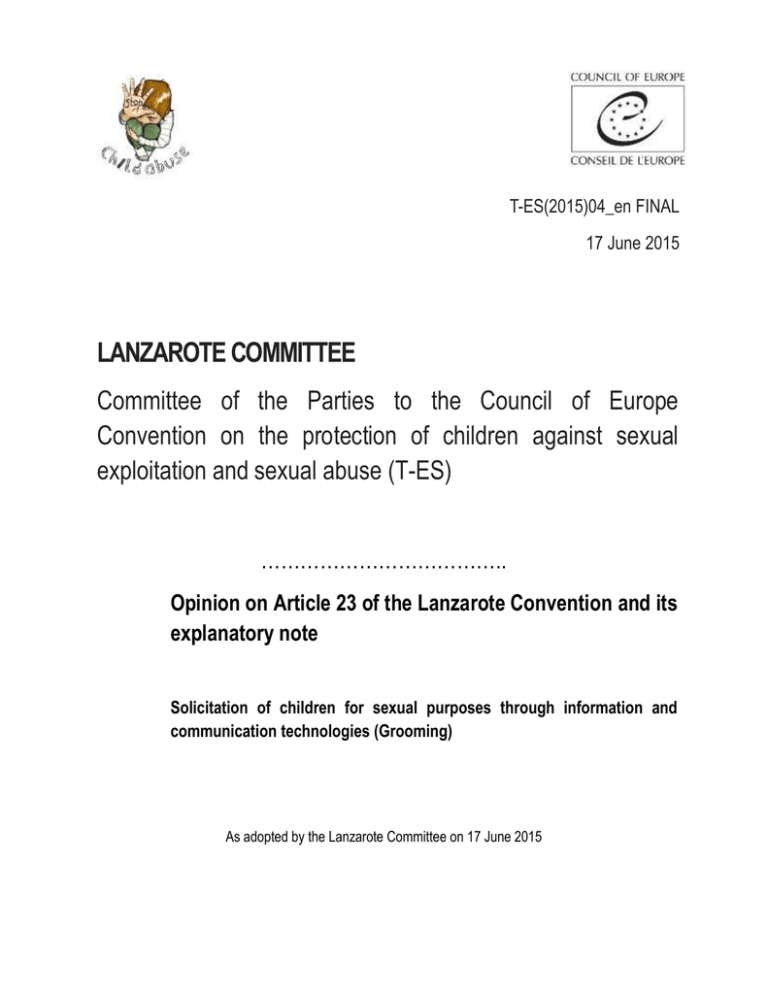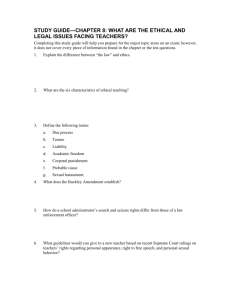
T-ES(2015)04_en FINAL
17 June 2015
LANZAROTE COMMITTEE
Committee of the Parties to the Council of Europe
Convention on the protection of children against sexual
exploitation and sexual abuse (T-ES)
………………………………..
Opinion on Article 23 of the Lanzarote Convention and its
explanatory note
Solicitation of children for sexual purposes through information and
communication technologies (Grooming)
As adopted by the Lanzarote Committee on 17 June 2015
OPINION
1.
Bearing in mind that children are increasingly using information and communication
technologies to communicate and form relationships, which may, in some cases, bring them into
contact with sexual offenders;
2.
Acknowledging that the Internet has created entirely new opportunities for sexual
offenders to target, groom and harm children;
3.
Recalling that Article 23 of the Lanzarote Convention requires Parties to criminalise the
intentional proposal of an adult to meet a child for the purpose of committing unlawful sexual
activities against him or her. This intention is organised and expressed through the means of
information and communication technologies and has to be followed by material acts leading to
such a meeting;
4.
Recalling that sexual activities are deemed unlawful when practiced by an adult with a
child who has not reached the legal age for sexual activities, which is set by national law and
differs throughout the Parties to the Lanzarote Convention;
5.
Noting that children who solicit other children with sexual intent are not covered by
Article 23;
6.
Noting also that the “solicitation of children for sexual purposes” is part of a practice
more commonly known as “grooming”;
7.
Concerned that, while online grooming may lead to an adult proposing to meet a child in
person with the intent of committing a sexual offence, it is also possible for sexual offences to be
committed exclusively online, nonetheless causing harm to the child;
8.
Bearing in mind that children may be exposed to some of the same risks online as
offline, such as being persuaded to engage in real or simulated sexually explicit conduct, being
recruited or coerced to participate in pornographic performances, or caused to witness sexual
abuse or sexual activities;
9.
Noting that if the sexual abuse of the child is committed exclusively online, there are no
material acts leading to a meeting in person, which represents a constitutive element of the
criminal offence set forth by Article 23;
10.
Considering moreover, that manipulating the child corresponds to a process which is
sometimes extremely difficult to detect as the offender’s motivation may change over the course
of an interaction, and specific grooming behaviours may not actually exist from the outset;
11.
Concerned that the acts leading to the sexual abuse committed exclusively online may
not be adequately recognised as criminal and therefore remain unpunished;
2
12.
Recognising that investigating an online interaction, which may or may not result in a
meeting between an adult and a child, raises many challenges;
13.
Bearing in mind that the emergence of cases where adults solicit children online can
attract large scale media coverage, and that this may convey the impression that state authorities
have not taken adequate action and expressing concern that as a result, “anti-Paedophile
activism” aimed at tracking down and exposing alleged sexual offenders outside the confines of
due legal process has emerged;
The Committee holds that:
14.
The unlawful behaviours covered by Article 23 are the acts leading to sexual abuse of a
child who has not reached the legal age for sexual activities (Article 18§1.a) and the production of
child pornography (Article 20§1.a).
15.
Article 23 of the Lanzarote Convention does not require the offences mentioned above
to be actually committed but aims at criminalising the adult’s preparation of the offences.
16.
States may consider encouraging law enforcement to prevent the commitment of sexual
offences, including online grooming, against children through information and communication
technologies.
17.
The solicitation of children through information and communication technologies does
not necessarily result in a meeting in person. It may remain online and nonetheless cause serious
harm to the child. The sexual offences which are intentionally perpetrated during an online
meeting through communication technologies are often linked to the production, possession and
transmission of child pornography.
18.
Although under Article 23 only the production of child pornography is referred to (as
Article 23 only refers to Article 20§1.a), Parties are reminded that other unlawful behaviours that
may take place online are covered and criminalised under other provisions of the Convention:
Article 20§1 of the Convention also criminalises the intentional conduct of:
b.
offering or making available child pornography;
c.
distributing or transmitting child pornography;
d.
procuring child pornography for oneself or for another person;
e.
possessing child pornography;
f.
knowingly obtaining access, through information and communication technologies, to
child pornography.
3
Article 21§1 of the Convention criminalises the intentional conduct, of:
a.
Recruiting a child into participating in pornographic performances or causing a child to
participate in such performances;
b.
Coercing a child into participating in pornographic performances or profiting from or
otherwise exploiting a child for such purposes;
c.
Knowingly attending pornographic performances involving the participation of children.
Article 22 of the Convention criminalises the intentional causing for sexual purposes of a child
to witness sexual abuse or sexual activities, without even having to participate.
Article 24§2 of the Convention establishes as criminal offences, when committed intentionally,
attempts to commit the offences established in accordance with the Convention.
19.
In the light of the difficulties and issues recalled above, the requirements inherent to
Article 23 of the Lanzarote Convention may not meet today’s and, more importantly, tomorrow’s
challenges with regard to online grooming.
20.
The overall phenomenon of online grooming evolves in parallel to information and
communication technologies. Its understanding should therefore not restrict itself to the way
online grooming was committed when the Convention was drafted, but should be understood and
tackled according to how it is being committed today and could be committed tomorrow. As no
static definition of online grooming is possible, Parties should consider extending its
criminalisation also to cases when the sexual abuse is not the result of a meeting in person, but is
committed online.
21.
The responsibility for the investigation and prosecution of online grooming should
remain with law enforcement authorities and the criminal justice system. When appropriate,
assistance may be requested from specialised NGOs, but neither these nor the public should
become the de facto agency of law enforcement.
22.
In this respect, Parties should, without prejudice to national law, make sure that making
private information on alleged sexual offenders public, is not permitted.
23.
In order for the investigation and prosecution of online grooming to be effective, there
is a great need to ensure that training and resources are allocated to all authorities responsible for
the investigation of cases, prosecution of offenders and protection of victims of online grooming.
24.
Civil society also plays a key role in protecting children and young people who have been
victims of sexual abuse and exploitation. Adequate means should therefore also be allocated to
these.
4
25.
Children should be empowered to enjoy the advantages of information and
communication technologies. They should be taught about the risks and dangers inherent to the
digital world, especially those generated by the over-sexualisation of society. The opportunities
and risks of information and communication technologies should be included in all school
curricula.
EXPLANATORY NOTE
1.
The Convention on the Protection of Children against Sexual Exploitation and Sexual
Abuse, hereinafter the “Lanzarote Convention”, was the first international instrument to
criminalise the solicitation of children for sexual purposes through information and
communication technologies (ICTs).
Article 23: Solicitation of children for sexual purposes
“Each Party shall take the necessary legislative or other measures to criminalise the intentional proposal,
through information and communication technologies, of an adult to meet a child who has not reached the age
set in application of Article 18, paragraph 2, for the purpose of committing any of the offences established in
accordance with Article 18, paragraph 1.a, or Article 20, paragraph 1.a, against him or her, where this proposal
has been followed by material acts leading to such a meeting.”
Explanatory report:
155. Article 23 introduces a new offence in the Convention which is not present in other existing international
instruments in the field. The solicitation of children for sexual purposes is more commonly known as
“grooming”. The negotiators felt it was essential for the Convention to reflect the recent but increasingly
worrying phenomenon of children being sexually harmed in meetings with adults whom they had initially
encountered in cyberspace, specifically in Internet chat rooms or game sites.
156. The term “grooming” refers to the preparation of a child for sexual abuse, motivated by the desire to use
the child for sexual gratification. It may involve the befriending of a child, often through the adult pretending to
be another young person, drawing the child into discussing intimate matters, and gradually exposing the child to
sexually explicit materials in order to reduce resistance or inhibitions about sex. The child may also be drawn
into producing child pornography by sending compromising personal photos using a digital camera, web-cam or
phone-cam, which provides the groomer with a means of controlling the child through threats. Where a physical
meeting is arranged the child may be sexually abused or otherwise harmed.”
157. The negotiators felt that simply sexual chatting with a child, albeit as part of the preparation of the child for
sexual abuse, was insufficient in itself to incur criminal responsibility. A further element was needed. Article 23,
therefore, requires Parties to criminalise the intentional “proposal of an adult to meet a child who has not
reached the age set in application of Article 18 paragraph 2” for the purpose of committing any of the offences
established in accordance with Article 18 paragraph 1 a or Article 20 paragraph 1 a against him or her. Thus the
relationship-forming contacts must be followed by a proposal to meet the child.
158. All the elements of the offence must be committed intentionally. In addition, the “purpose” of the proposal
to meet the child for committing any of the specified offences needs to be established before criminal
responsibility is incurred
159. The offence can only be committed “through the use of information and communication technologies”.
Other forms of grooming through real contacts or non-electronic communications are outside the scope of the
provision. In view of the particular danger inherent in the use of such technologies due to the difficulty of
monitoring them the negotiators wished to focus the provision exclusively on the most dangerous method of
5
grooming children which is through the Internet and by using mobile phones to which even very young children
increasingly now have access.
160. In addition to the elements specified above the offence is only complete if the proposal to meet “has been
followed by material acts leading to such a meeting”. This requires concrete actions, such as, for example, the
fact of the perpetrator arriving at the meeting place
2.
As recalled in the Explanatory Report with reference to Article 23 of the Convention
(§156), the concept of an “online solicitation” is part of a practice more commonly known as
“grooming”, and covers an increasingly worrying phenomenon of children being sexually
harmed by adults whom they had initially encountered in cyberspace. Although the act of
grooming is not a new tactic, the fact that it can now be done online offers offenders new
possibilities to solicit children in a faster and more anonymous way and in higher numbers.
3.
The adult can incur criminal responsibility under Article 23 if he/she proposes to meet a
child through ICTs. Paramount for criminal responsibility to be incurred, the proposal needs to
be followed by material acts leading to such a meeting. As an example, the adult arriving at the
meeting place is what can be considered as a material act (§160).
4.
The drafters of the Convention deliberately chose to limit the scope of Article 23 to the
situation where the intentional proposal of an adult to meet the child with the aim to sexually
abuse her or him is expressed through ICTs and is followed by material acts leading to such a
meeting. It is however increasingly acknowledged that sexual offences against children may be
committed exclusively online. In such cases, by definition, no material acts leading to a meeting
in person exist and thus the situation cannot be prosecuted within the scope of Article 23.
5.
In this context, the Committee of the Parties of the Lanzarote Convention (hereinafter
referred to as “the Lanzarote Committee”), agreed that it had to reiterate the scope of
application of Article 23. Additionally, it agreed that with respect to the challenges raised by the
above mentioned new situation, it should provide some guidance to Parties wishing to go
beyond the requirements of Article 23.
6.
The objective of this opinion is therefore twofold:
(a) to recall the requirements of Article 23 and its scope of application and
(b) to provide guidance to those Parties that would wish to go beyond the requirements
and scope of Article 23.
The scope of Article 23
7.
To ensure compliance with Article 23, Parties must criminalise the intentional proposal
of an adult wanting to meet a child for the purpose of committing the offences specified in
Article 18§1.a (Engaging in sexual activities with a child) and 20§1.a (Producing child
pornography). The concrete steps taken by the adult in order to meet the child in person
constitute an essential element of the offence.
6
8.
The understanding of the term “intentional proposal” is paramount to the overall
application of Article 23. The drafters of the Convention agreed that “simply sexual chatting
with a child, albeit as part of the preparation of a child for sexual abuse, [is] insufficient in itself
to incur criminal responsibility (§157 of the Explanatory Report).
9.
Grooming children online may be achieved through a “screen-to-screen” chat
conversation or by communicating through webcams. In both cases, the grooming process can
be heavily facilitated through the use of mobile phone applications. Initial contact between a
child and an adult may take place in various online environments, such as through social
networking platforms and online games. Thus, it is not necessary for the adult to meet the child
in person to sexually abuse her or him.
10.
While communicating online, the adult although not physically present, can cause the
child to witness, watch or take part in the production of child pornography. This material can
not only be watched by the offender but can also be circulated online. Once circulated online, it
can be extremely difficult to delete and thus creates further and long lasting abuse and harm to
the child.
The relevance of other provisions of the Lanzarote Convention
11.
Article 23 is not the provision to rely on when criminalising sexual abuse which has
remained only online.
If the adult’s manipulation has remained online and resulted in him or her succeeding to
lure the child into acts such as sharing sexually explicit photos or performing sexual
conducts in front of the webcam the adult may be charged with the criminal offences set
out in Article 20§1.a (Production of child pornography).
If the adult’s manipulation was not limited to the production of child pornography, the adult
may be charged under another sub paragraph or the entirety of Article 20 (producing,
offering or making available, distributing or transmitting, procuring and possessing child
pornography, knowingly obtaining access to child pornography).
12.
Additionally, Parties are reminded that recruiting and coercing a child into participating
in pornographic performances is criminalised under Article 21 and that the intentional causing
for sexual purposes of a child to witness sexual abuse and activities, even without the child
having to participate, is criminalised under Article 22.
13.
Finally, Article 24§2 is also relevant, as it requires Parties to “establish as criminal
offences, when committed intentionally, attempts to commit the offences established in
accordance with the Convention”.
7
Difficulties in investigating and in prosecuting online grooming when it occurs beyond the
scope of Article 23 and guidance to Parties wishing to go beyond Article 23
14.
Parties should consider extending criminalisation of online grooming also to cases when
the sexual abuse is not the result of a meeting in person, but is committed online.
15.
To counteract online grooming, appropriate means and specific training for the relevant
authorities must be ensured by the Parties.
16.
Prosecutors, law enforcement authorities and other professionals should have or
continue to have, access to training on the challenges of prosecuting cases in which a child has
willingly engaged virtually or in person, in sexual activities, with an adult.
17.
Parties may also consider encouraging law enforcement to prevent the commitment of
sexual offences, including online grooming, against children through ICTs.
a.
The case of anti-paedophile activism
18.
Child sexual abuse and exploitation may be difficult to detect and may only come to the
attention of law enforcement authorities when a victim comes forward and discloses the abuse,
or as a result of investigations conducted by the competent authorities. Offences may therefore
stay unrecognised and unknown.
19.
As a consequence, certain individuals, and even some NGOs and media have taken or
may take the initiative to track down and expose alleged sexual offenders outside the confines
of due legal process. Parties should make sure that these are discouraged from taking the role
of law enforcement.
20.
In some specific cases however, a collaborative work between specialised NGOs and law
enforcement may prove valuable. Such collaboration should be strictly supervised by
competent authorities.
b.
The impact of the over-sexualisation of society
21.
Another facilitating factor for online grooming is the fact that children have the
impression that it is acceptable to exchange/circulate sexual images of themselves via the social
media, etc. (so called “sexting”). In other words, children can be more inclined to sending and
exchanging sexually explicit messages or photos to their friends or even to people they have
just met online without considering the risks involved.
22.
Parties are reminded that even if the child has participated in the grooming process by
willingly sharing sexually explicit pictures of themselves with the offender, this shall not in any
way alter the criminality of the adult’s behaviour.
8
23.
The best interest of the child is a dynamic concept that encompasses various issues
which are continuously evolving. Prevention of online grooming should be based on the
understanding of the inappropriate nature of certain relationships (adult-children-who have not
reached the legal age for sexual activities) rather than on all relationships.
24.
There is a determined and compelling need to build the capacity of children to live in a
digital world. Parties have the obligation to prevent sexual violence against children. Children,
parents and care takers should have access to information and counselling services on the risks
and dangers inherent to the digital world. The opportunities and risks of ICTs should be
included in all school curricula.
9



